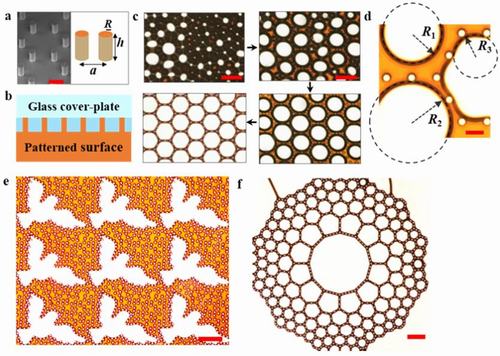Scientists Advance a General Patterning Approach by Manipulating the Evolution of Two-dimensional Liquid Foams
Foams have wide applications in industry because of their lightness, very larger specific surface area, acoustic and optical properties, and the fact that they exhibit both solid and liquid behavior. Since Plateau opened up the foam physics in 1873, many efforts have been made to investigate the structure of foams, and the structural evolution with the time. However, it remains a challenge to control the evolution of foams, which limits their further applications. The difficulty mainly results from the Ostwald ripening of bubbles in foams. Namely, larger bubbles always consume smaller ones owing to the pressure difference between bubbles of different size.
Based on the principle that micropatterned surface can effectively regulate the gas-liquid interface, Prof. SONG Yanlin from Institute of Chemistry of Chinese Academy of Sciences (CAS) focuses on manipulating the evolution of 2D liquid foams with a mciropatterned surface. This work has been published in Nature Communications.
They found that when foams evolve in the quasi-2D space consisted of a micropatterned surface and a flat glass cover-plate, the phenomenon of Ostawald ripening doesn’t necessarily occur. The micropatterned surface can guide the evolution of 2D foams into equal sized bubble patterns. The mechanism is that pillars on the micropatterned surface can effectively manipulate the radii of curvature of bubbles when bubbles grow and evolve. The radius of curvature determines the pressure of bubbles, which determines the gas transport between bubbles that affects the total evolution. By changing the geometries of pillars, the various patterned foams can be achieved. For applications, the patterned foams can serve as the template for assembly of functional nanoparticles, which provides a feasible strategy for the fabrication of optoelectronic devices.
This work demonstrates that foams can evolve beyond the Ostwald ripening under the guidance of micropatterned surface, which changes traditional idea that foams are unstable and difficult to be controlled.

Manipulating the evolution of 2D foams assisted by the micropatterned surface (a-d) and patterned foams. (Image by Prof. SONG Yanlin)
Contact:
Prof. SONG Yanlin
Laboratory of Green Printing, Institute of Chemistry, Chinese Academy of Sciences,
Email: ylsong@iccas.ac.cn





